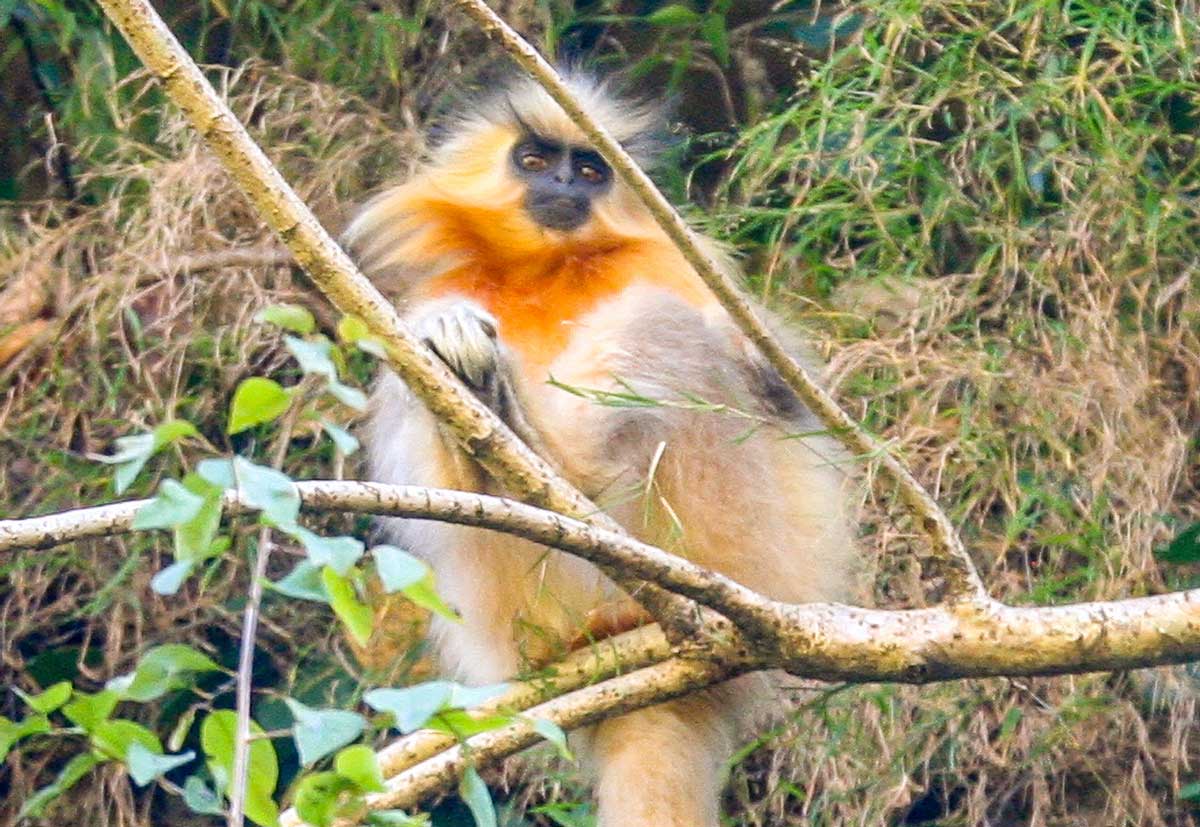
Bhutan
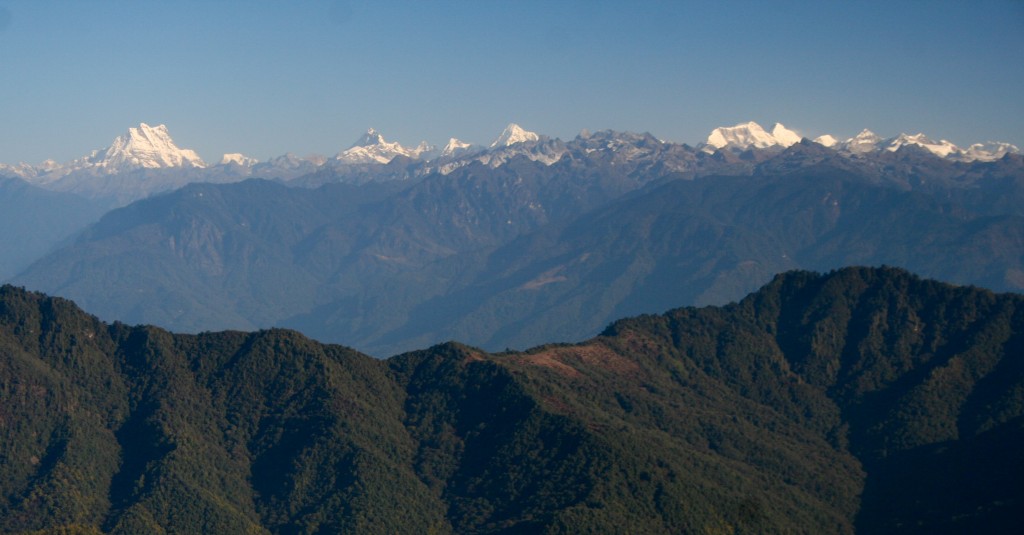
The view from Dolchu La
Bhutan, the land of the thunder dragon, is an extraordinary country. They have managed to protect their culture and their forest (some 70% of the country is still forested), and most of the country that I saw was just plain beautiful. It is, however, quite difficult to get to, and quite expensive when you get there. So when I was invited to a conference in November 2008 it took me all of three seconds to carefully weigh up the pros and cons.
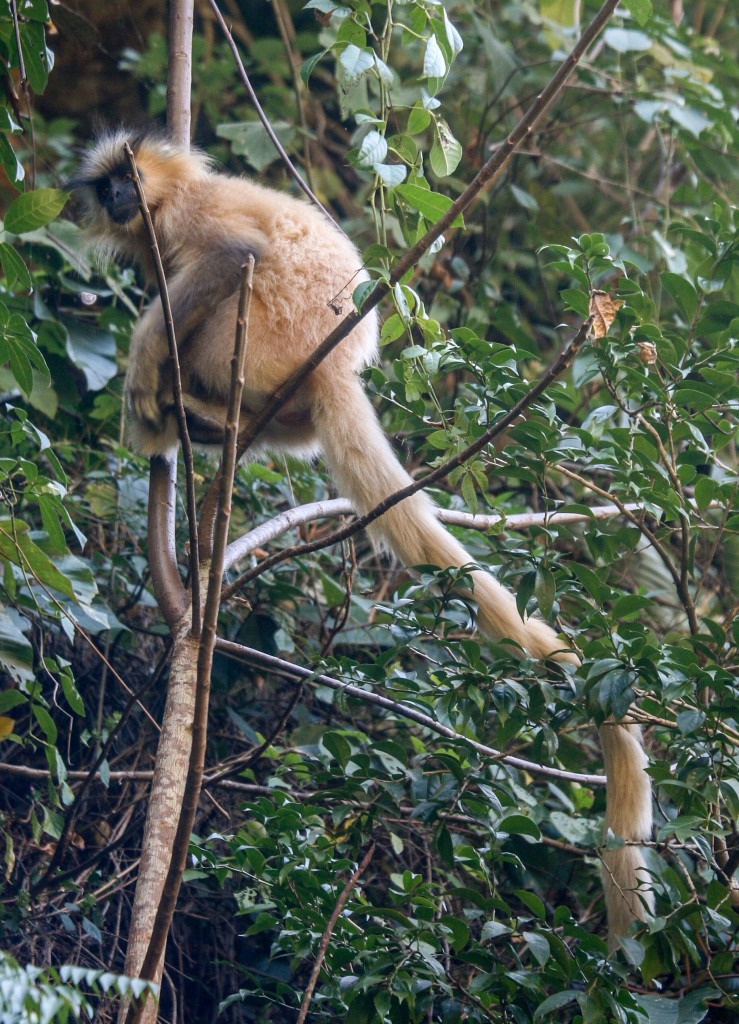
Bhutan Golden Langur, Trachypithecus geei bhutanensis
Although Bhutan’s environment is well protected, the Bhutanese tour operators were not particularly optimistic about the chances of seeing many mammals. In recent years the country has become a popular bird watching destination, but I couldn’t find much information on places to see most of the mammals I was after. Roads do not get above 4,000 metres so a lot of the higher altitude stuff could apparently only be seen with a week long trek. And I was told I had just a slim possibility of seeing most of the other more interesting species, aside from the primates.
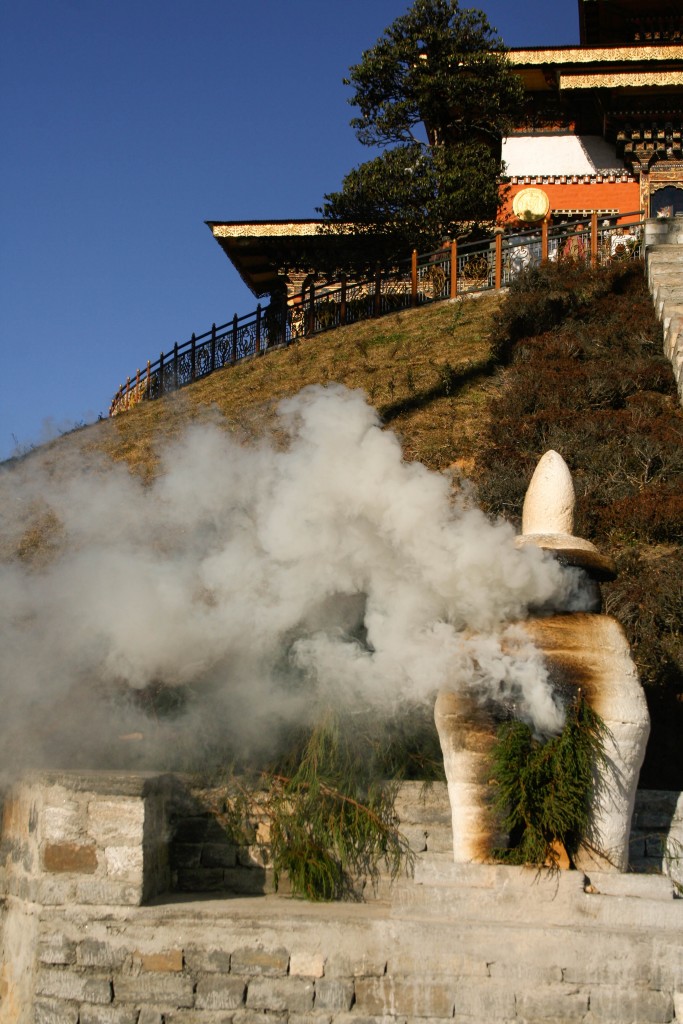
Temple at Dolchu La
Some Observations
Bhutanese people are unfailing friendly and polite, food and drink is cheap, and the hotels I stayed in were comfortable.
The longest stretch of straight tarmac in Bhutan is the runway at Paro airport. The main roads are in reasonable condition, but they are all single lane, and are always either winding up or winding down a mountain. If you can average more than 30 kmh on a trip you are probably driving too fast.
There doesn’t seem to be any agreed English spelling for most Bhutanese place names. I have used the spelling on my tourist map, but English signs in many places offered a different word. However, the words were usually phonetically the same (is that a homonym?) so if it sounds right then you probably have the right place.
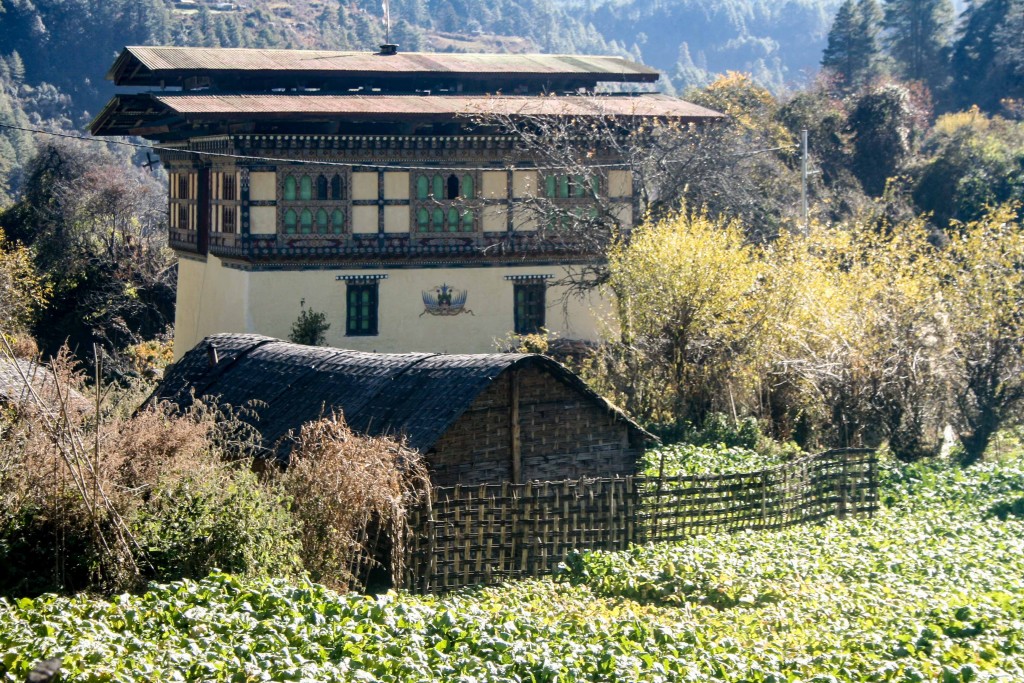
Some Useful Tips
The food they serve tourists in most hotels is bland and less inspiring than the food they give to the locals. If you don’t mind some spice then try chillies and cheese. If you don’t mind some heart disease then try the air dried pork (which is Bhutanese for “bacon fat”). Talking of heart disease, cigarettes are banned in Bhutan, though most Bhutanese smoke openly and pay inflated black market prices. Tourists can bring cigarettes into the country after paying 200% tax.
Most visitors arrive into Paro airport. It is free seating on the planes, so try to grab a seat on the left coming into the country for a chance to see Everest. And concentrate on the view as you land, rather than the manoeuvres the pilot has to make to avoid the mountains as he comes down. Yikes.
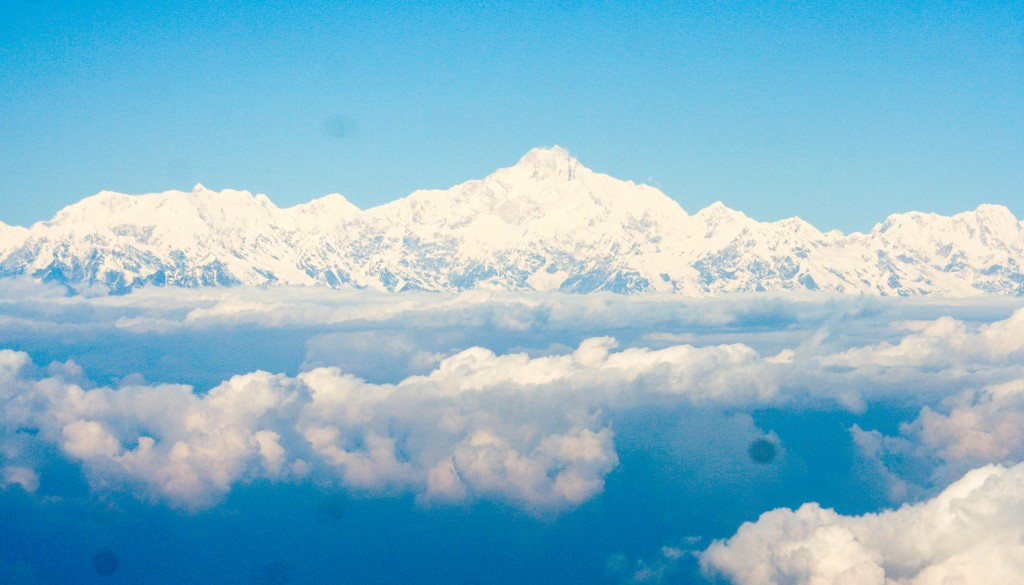
Everest… at least I think it is
Archery is the most popular sport in Bhutan. Archery ranges appear in unexpected places, so take care. I was almost taken out when I walked along a footpath across a patch of grass in a village and was one step short of becoming a kebab.
Finally, although there are no billboards in Bhutan, their public information signs get directly to the point.
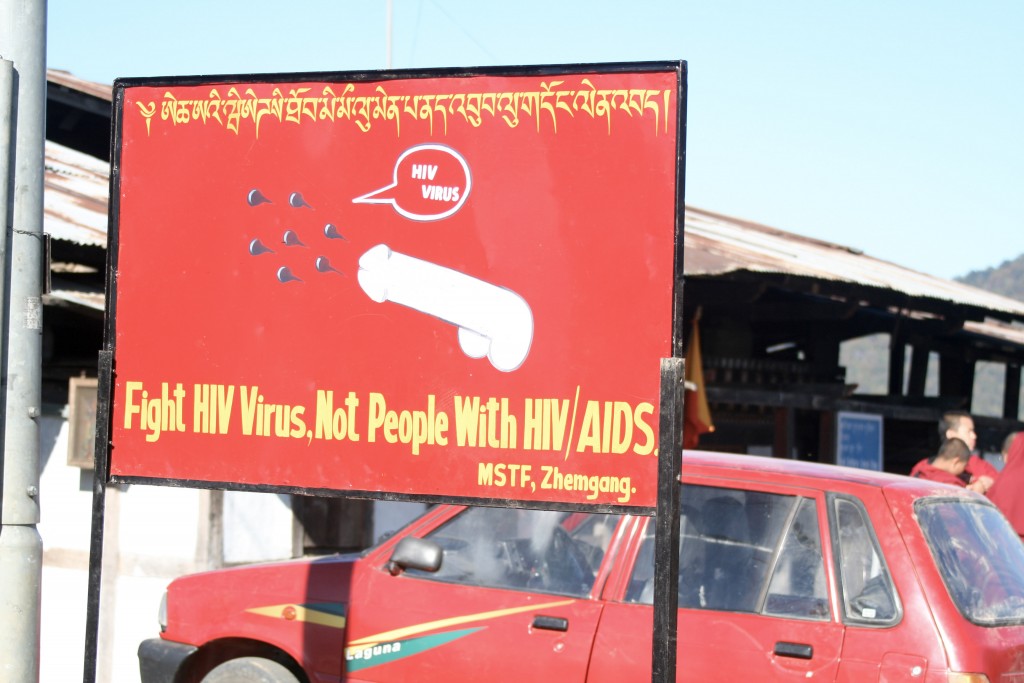
I was sad to leave Bhutan after just a week there. It made an impression on me the way few countries do and I hope to return, not just because there are more mammals to see, but because of the country itself.
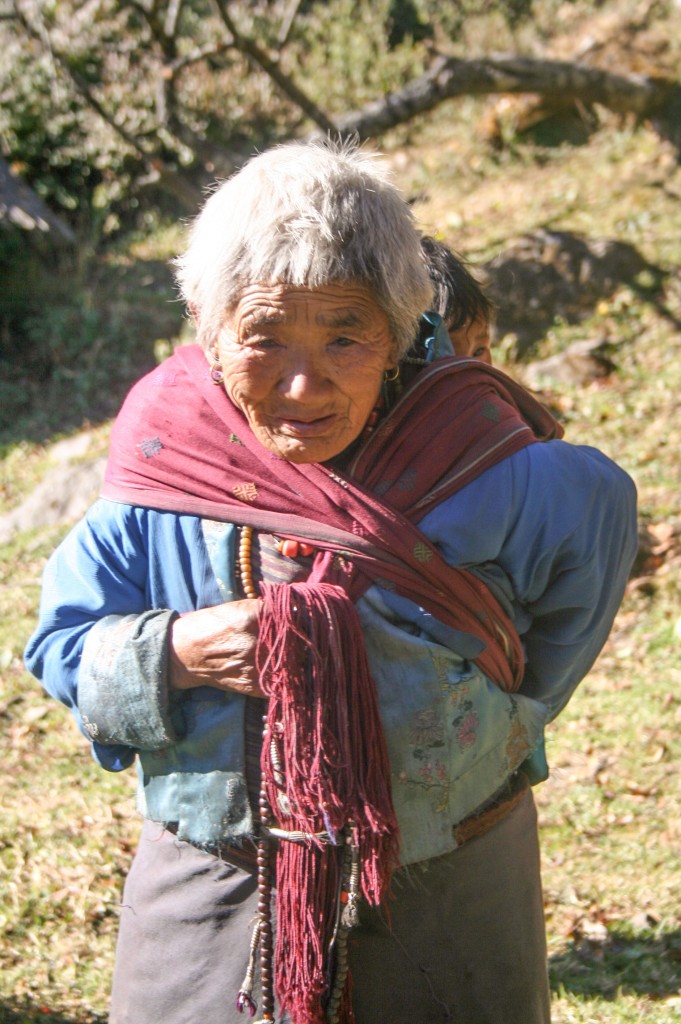
Great Great Grandmother
On the advice of Dion Hobcroft (see his notes), I arranged a short tour after my conference with Journey to Bhutan Tours. The guide Dion recommended – Karma Tshering – wasn’t available but he did help me plan my trip. They assigned me a wildlife guide from the Nature Conservation Department, Rinchen Singye. Rinchen is a great guy: primarily a birder he has a lot of field experience, had great eyes and knew some good sites for mammals. He was also happy to spend long hours spotlighting. Our driver, Chimi Rinzin comes similarly recommended. He was interested in the mammals, utterly reliable and also ready to drive all day then spend hours spotlighting.
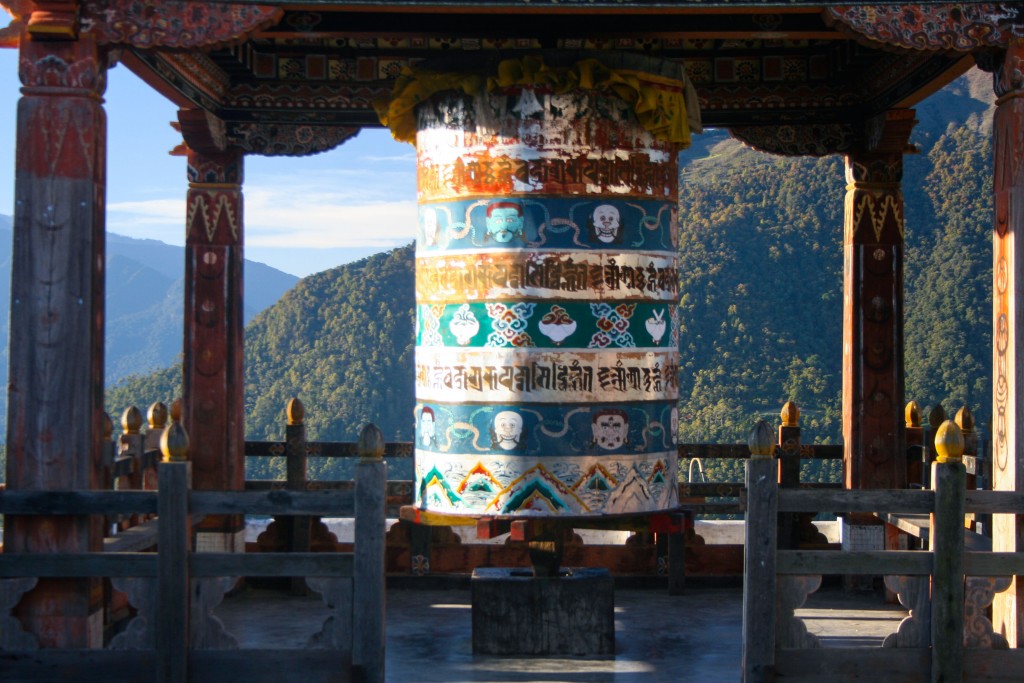
Prayer Wheel
Thimpu
Thimpu, the capital, is apparently mammal-less. I asked a few people whether there were any mammals around and was told no, though the field guide to the mammals of Bhutan reckons different: Himalayan Black Bears, for example, are frequently seen in apple orchards close to the city. There are however some Takin in Thimpu zoo. I am not sure if there are any other animals in the zoo. At least 20 people told me about them. I didn’t go.
The Takin has a typically Bhutanese story attached to it. “It is said that one day when Lama Drukpa Kinley, the ‘Divine Madman’ (and responsible for all the penises around the country), was visiting a village, his devotees gathered around him and asked him to perform a miracle. The Lama demanded that he first be given a whole cow and goat to eat. Having devoured both, leaving only the bones, he stuck the goat’s head on the bones of the cow and commanded it to come alive. The animal came to life and ran to the meadow and began grazing. It came to be known as the Dong Gyem Tsey (Takin) and can still be seen grazing in the mountain meadows of the Himalayan Kingdom.”…. well its more plausible than making the world in seven days and more entertaining too. And only in Bhutan would someone get the job to be responsible for all the penises in the country.
Dolchu La
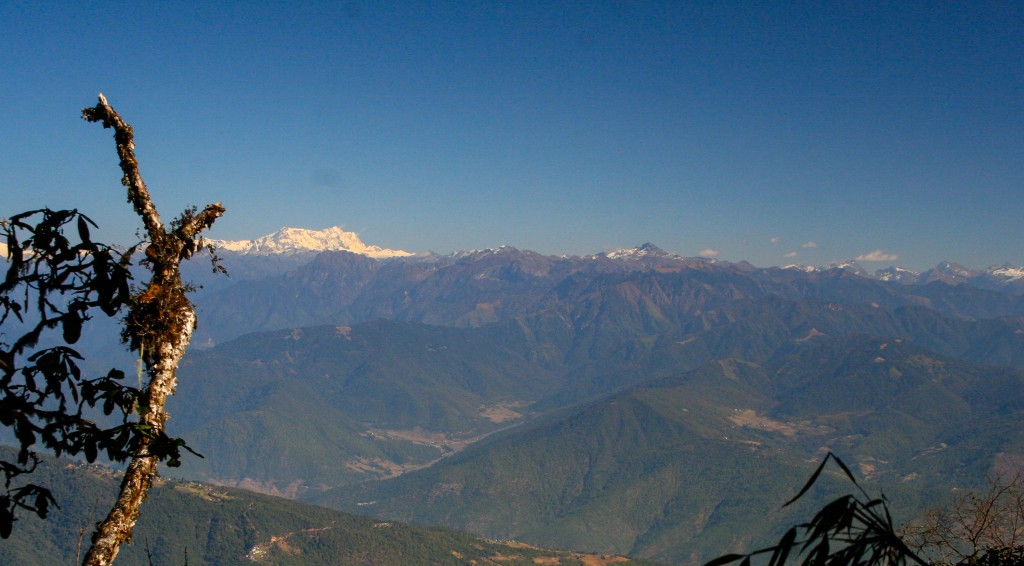
Dolchu La is a hilltop temple about 45 minutes east of Thimpu. It overlooks a Himalayan panorama that is ridiculously beautiful on a clear day. The weather seems always to be clear in November.
We took a short hike up the hill in front of the temple. There’s a chance for Musk Deer in this bit of forest but we were only there for an hour and a half, and for a third of the walk we were walking past villagers digging some kind of watercourse through the forest. So it isn’t all that surprising that we didn’t see any deer. But we did see two separate Yellow-throated Martens, which seem very common in this area.
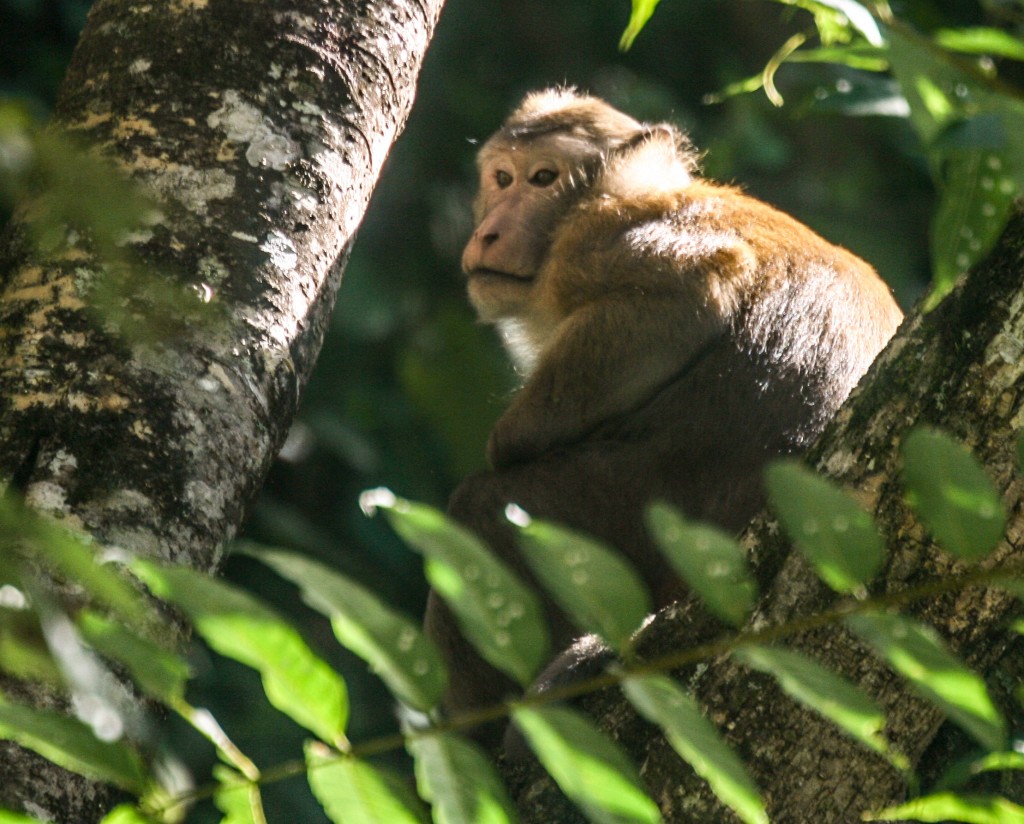
Assamese Macaque, Macaca assamensis
We drove on, stopping 10 minutes further down the road from the temple and hiked for a couple of hours along an old trail down the mountain side, looking for squirrels and monkeys. There was no sight or sign of squirrels, but we did find a big troop of Assamese Macaques, and lower down an equally big troop of Nepal Gray Langurs. Neither of the monkey troops were very approachable, and the langurs hooned off before I could get a decent photo. Rinchen also saw a Barking Deer. There was Leopard scat long the trail at two different spots, together with Wild Boar and Sambar tracks.
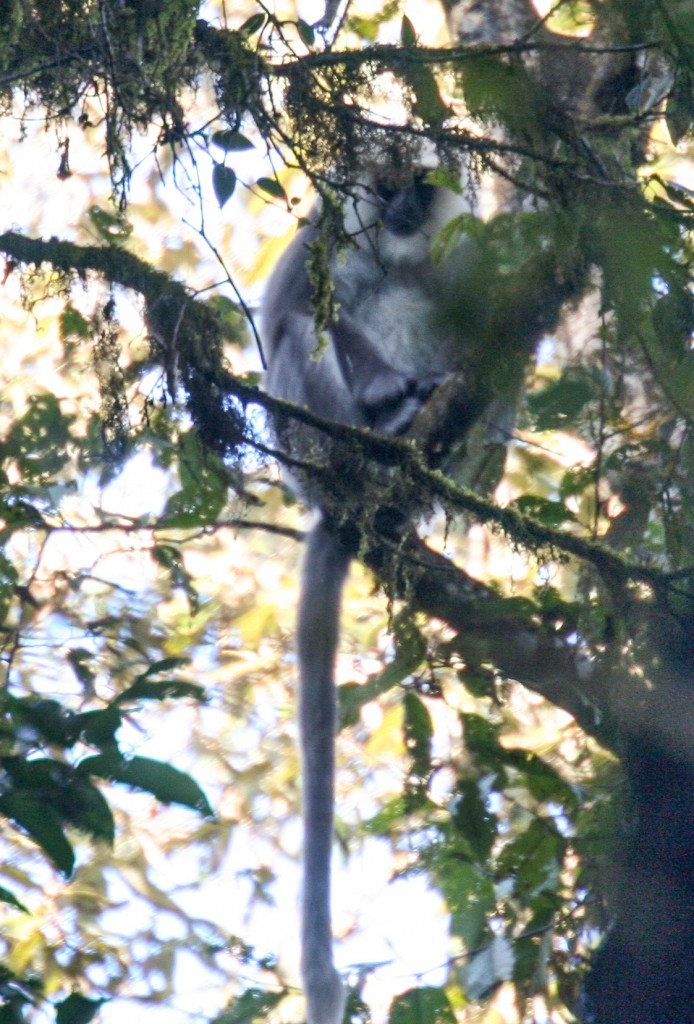
Nepal Grey Langur, Semnopithecus schistaceus
Chimi picked us up when we got back to the road and we spent the night at a hotel in Punakha, 30 minutes further down. The hotel was fine but it wasn’t particularly convenient for wildlife. I wanted to drive 20 minutes back up the mountain to return to the forest for some spotlighting. But Rinchen and I also decided to change our itinerary for the following day which meant he had to run some errands to change the hotel booking, and so spotlighting was cancelled.
Around Pele La
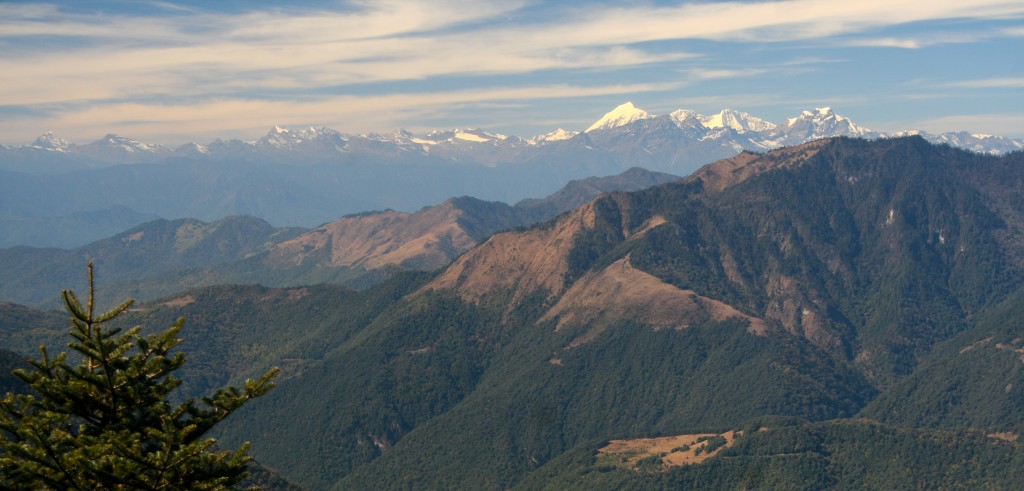
The next day we headed south to Wangdi Phodrang then east towards Tongsa. Rinchen thought we should stop a few kms before Nobding and take a walk along the road as he had seen a Serow in this area. Sure enough, after 30 minutes we heard, then saw, a Serow that was just 50 metres below the road in an open patch of forest. I’d seen a Serow once before in China, but that was while spotlighting, so the view was more of a silhouette with eyeshine. This time the view was good, albeit very short.
At Pele La, further up the mountain – up at 3,600m – we took a stroll along the old highway back down the hill. This is a good pika spot and we spotted two in 10 minutes, moving through open areas of the rhododendron forest. Both views were frustratingly brief and the animals quickly hid under or inside Rhododendron roots. At the time we thought this species was Royle’s Pika (on the basis of size and habitat) but perhaps Large-eared Pika is more likely. In 2024 Brett Hartl got pictures of pikas here and after discussion with pika expert Andrey Lissovsky I will record these as Sikim Pikas (Ochotona sikimaria). They are neither Royle’s nor Large-eared it seems.
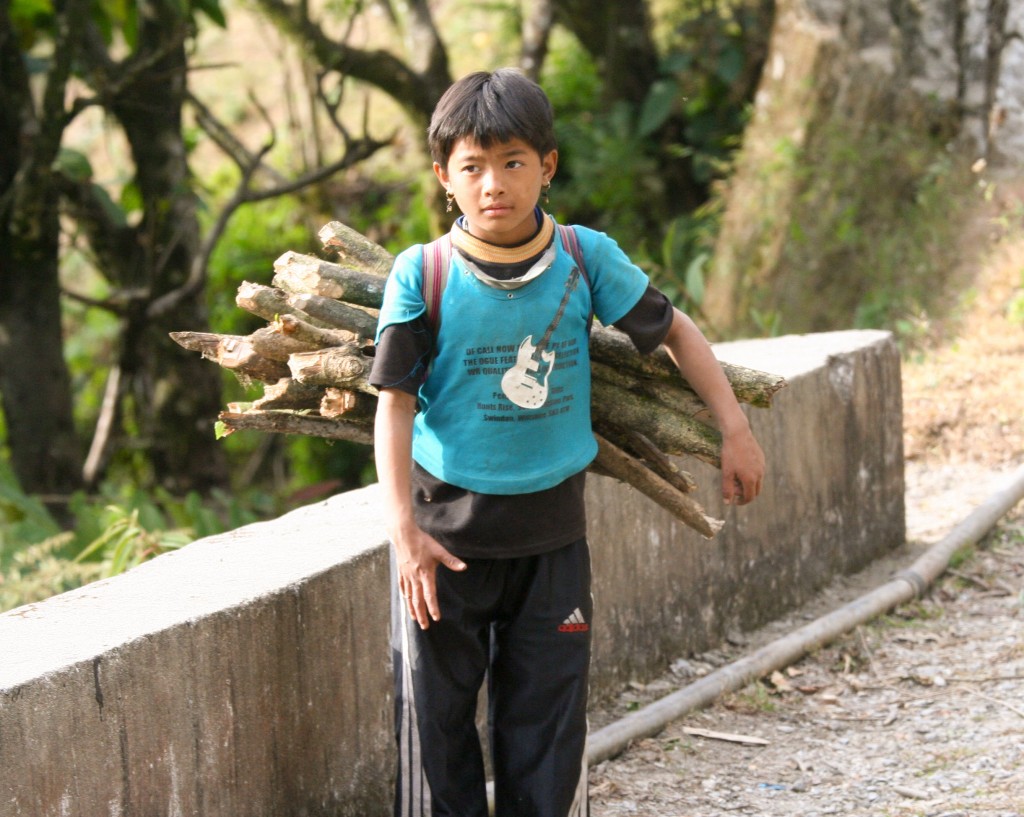
A half an hour later we were at our small hotel in Chenbeji. After lunch Rinchen took me to some oak forest about 3 km east of the hotel, and within five minutes we saw a pair of my first Orange-bellied Squirrels. We also heard what was probably a leopard. But that was it for the mammals that afternoon.
Spotlighting that night was very cold. We bumped into the park rangers on their way back to the village and one of them showed us a couple of spots where he’d seen Red Pandas this year. Both were on the other side of the river and inaccessible by car. So we decided to try for the pandas in the morning and went spotlighting instead along the road through some broad-leaved forest a couple of kilometres past the hotel. We saw a lone flying squirrel. It didn’t show itself properly but I saw enough to say it was a Parti-coloured Flying Squirrel: it was small and brown and considerably higher than the upper altitudinal range of a Hairy-footed Squirrel, the only alternative species I could think of. Rinchen also saw a Leopard Cat at the edge of the road.
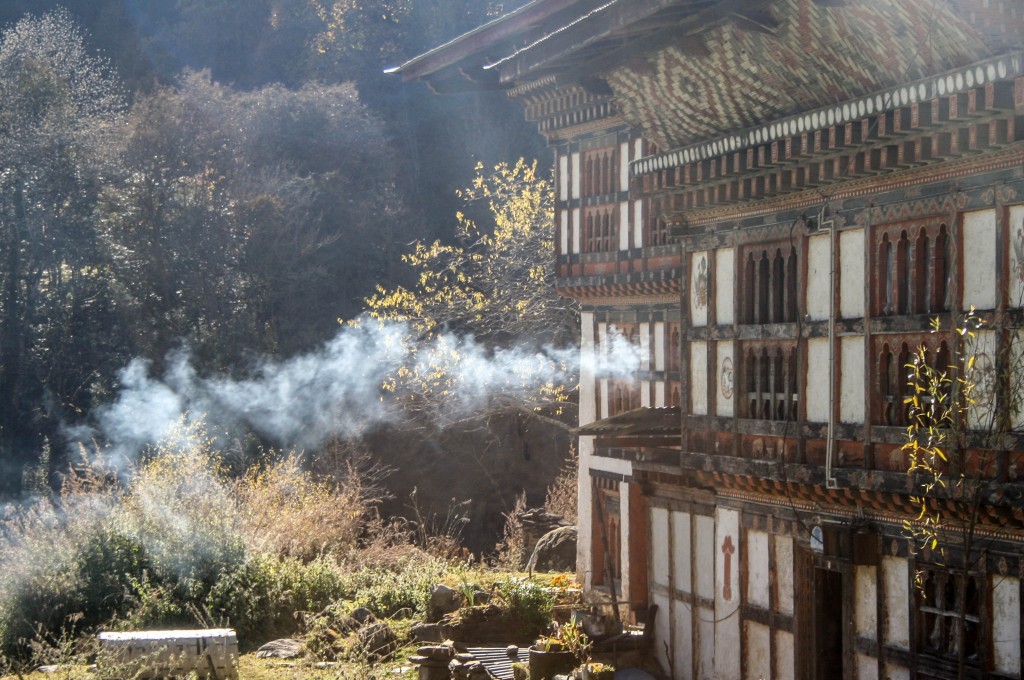
At breakfast the next morning, a few Assamese Macaques were sunning themselves across the river. We drove a few kilometres back west to a small village and walked upstream through some bamboo thickets where a Red Panda had been seen six months earlier. No pandas. No signs of pandas. So we walked downstream and climbed a steep ridge to a thicket of larger bamboo. The habitat looked very good but again no pandas. But we did see more Assamese Macaques near the village, and another Orange-bellied Squirrel. The villager who accompanied us spotted some marks which he said were fresh signs of a Himalayan Black Bear.
Tongsa
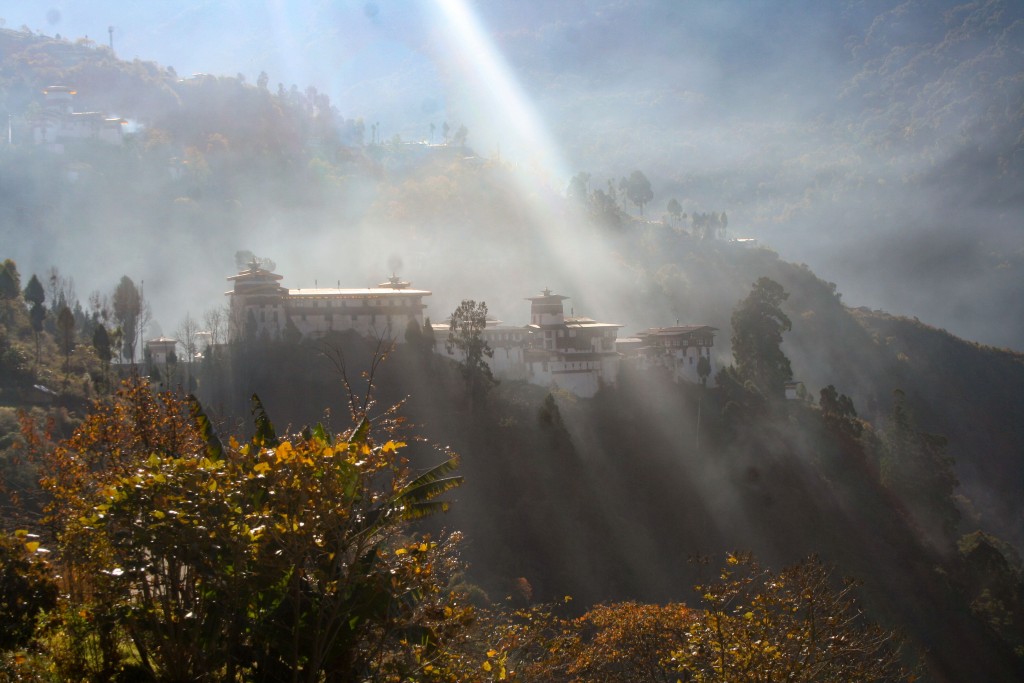
We were staying at Tongsa that night, which was only an hour away, so we first headed through Tongsa and continued east for another hour up to Yotang La, on the edge of Bumthang District. Red Pandas seem easier to see further east, but they are sighted here occasionally and the habitat looked good: the road went through lots of bamboo forest for the first few kilometres beyond Yotang La. We spent an hour poking around Pika habitat at Yotang La. No Pikas but plenty of scats. We then walked down the road through the bamboo until dusk. No mammals.
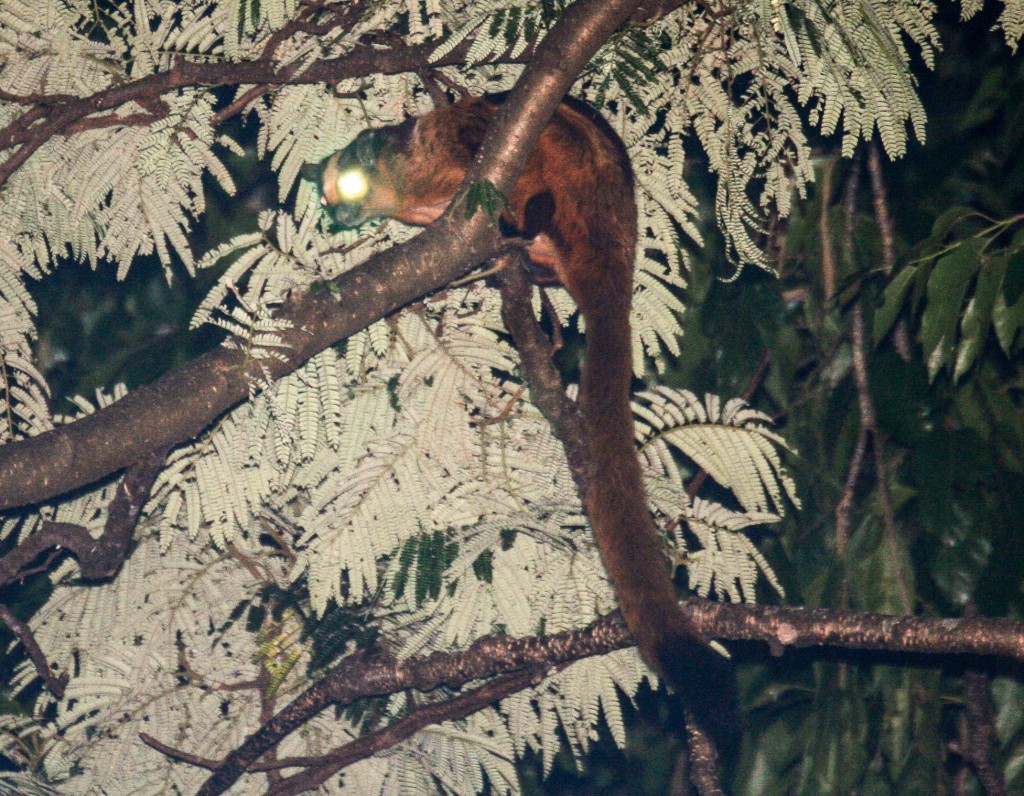
Bhutan Giant Flying Squirrel, Petaurista nobilis
Spotlighting all the way back to Tongsa was devoid of life until we got down to about 2600 metres. Rinchen spotted a flying squirrel which jumped and glided for about 60 metres. We had good views of it in flight and it was either a Bhutan or Hodgson’s (Himalayan) Flying Squirrel (Petaurista magnificens or Petaurista nobilis respectively).
A few km further down the road we had more eyeshine high up in a tree. I saw something red bounding along the branch, but other than that it was just eyeshine. It could conceivably have been a Red Panda, but was most probably another flying squirrel.
As we left the hotel the next day, one of the tour bus drivers spotted through a telescope some Golden Langurs on the cliff face across the river.
Gamzhang
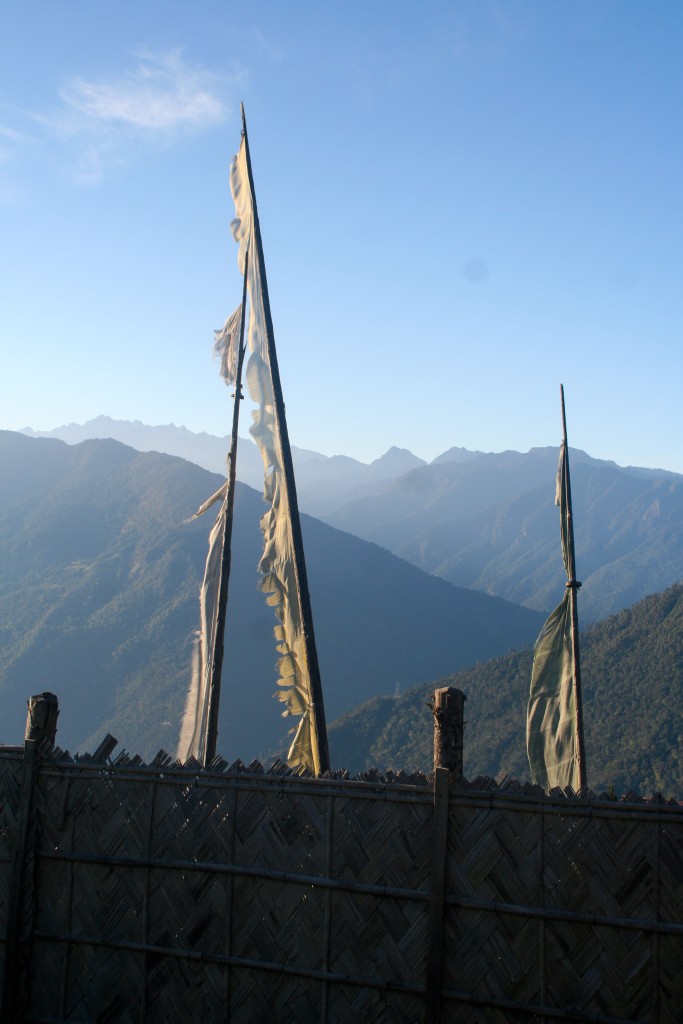
The drive was another slow, beautiful meander through forests and timeless villages, with occasional breathtaking mountains thrown in for good measure.
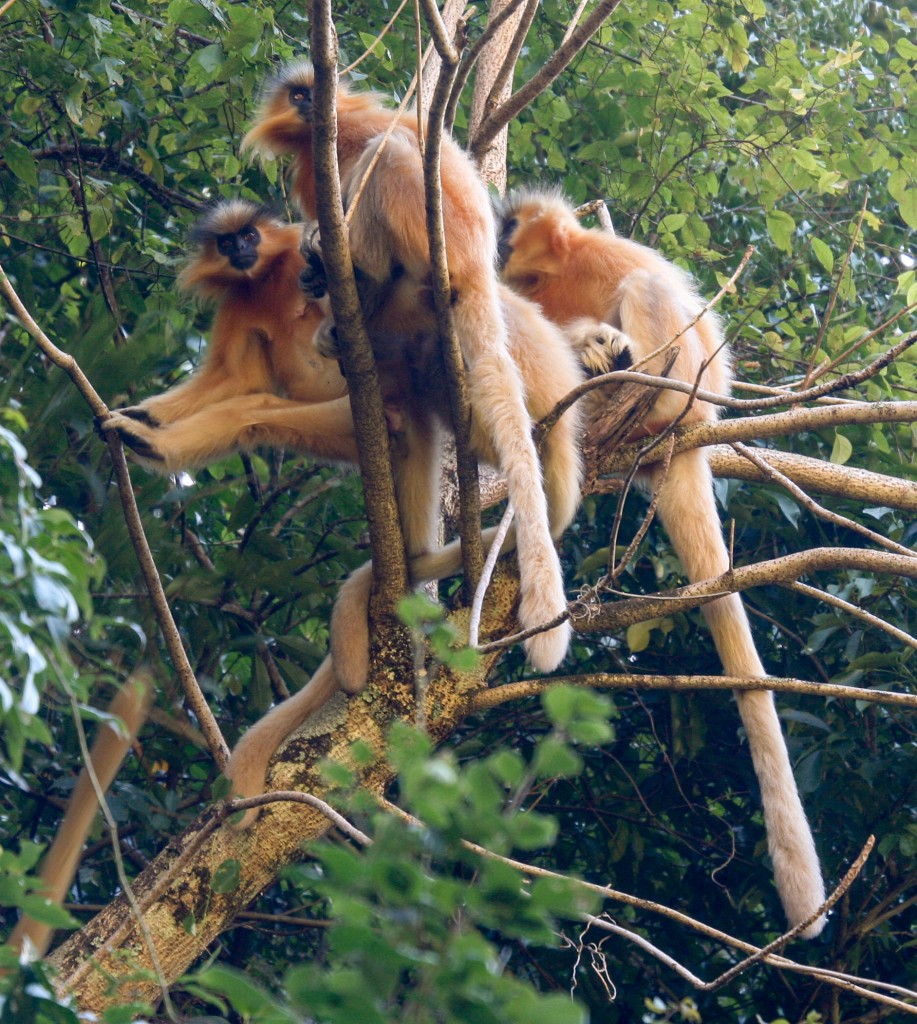
Bhutan Golden Langur, Trachypithecus geei bhutanensis
We got a better look at Golden Langurs (the bhutanensis subspecies) just before the village of Langthel. Ten or so were in trees overhanging the road and were not at all concerned to see me.
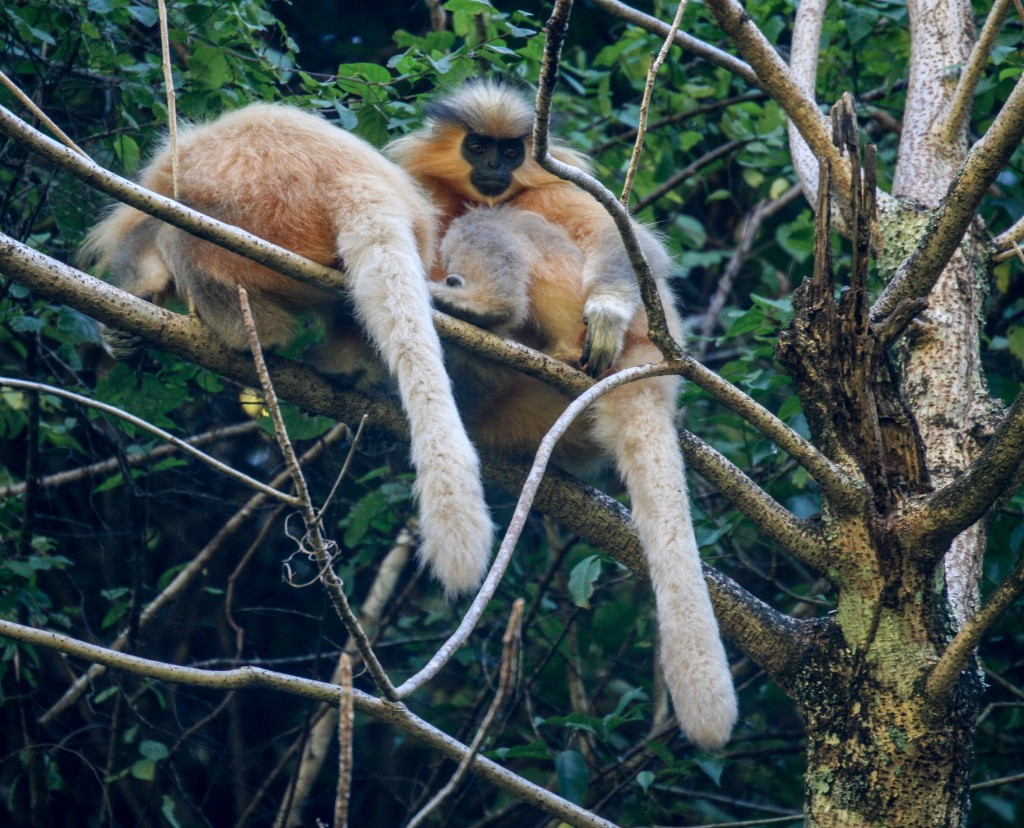
Bhutan Golden Langur, Trachypithecus geei bhutanensis
There were more at the road side just before Gamzhang. Really lovely primates.
Gamzhang is on the side of a mountain and the views, as usual, were stunning. It is also off the tourist trail. Few foreigners pass this way and even fewer stop, so my arrival was a cause of some excitement among the local kids, a few of whom followed me through the town. One spoke English and asked me “which village do you come from?”.
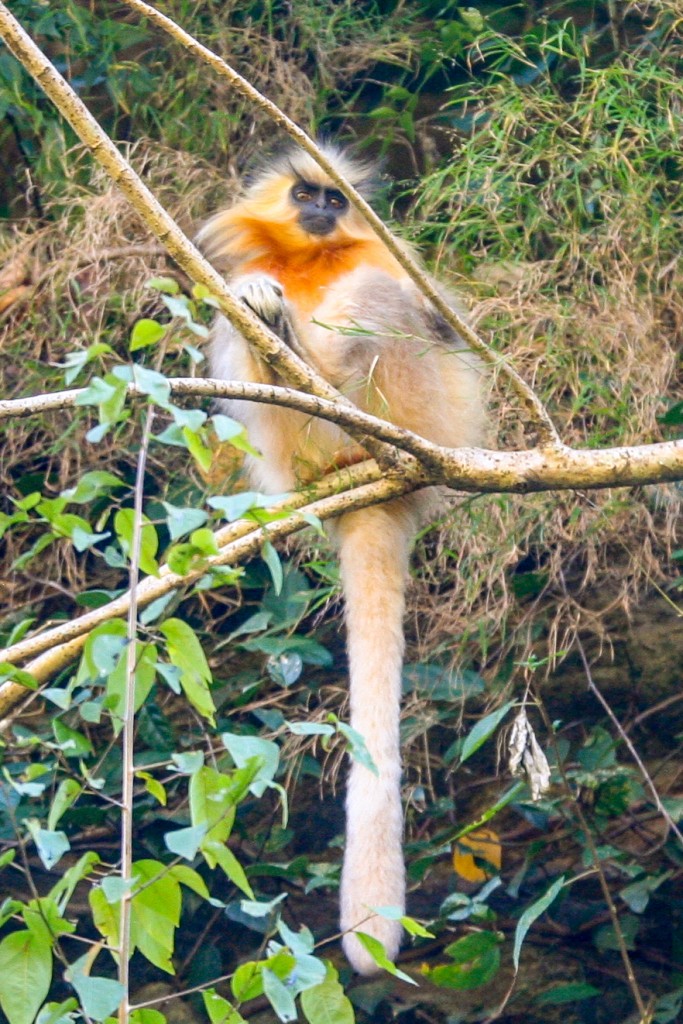
Bhutan Golden Langur, Trachypithecus geei bhutanensis
We went out spotlighting at 7 p.m. in the forest south of the village. It was a good night.
Rinchen spotted a Sambar on the rocky slope above the road. About 10 km down the road I saw the back three-quartes of a cat jump off the road. It was yellow, large, with a black tipped tail …. a Golden Cat! Totally unexpected, and this is a species that is very hard to see anywhere it seems. Indeed I thought I might have imagined it. But both Rinchen and Chimi (neither of whom had seen one before) confirmed what I had seen and picked it from the field guide, without any leading questions from me. My best mammal of the year (alongside a Wolverine), even if the sighting was far from satisfactory.
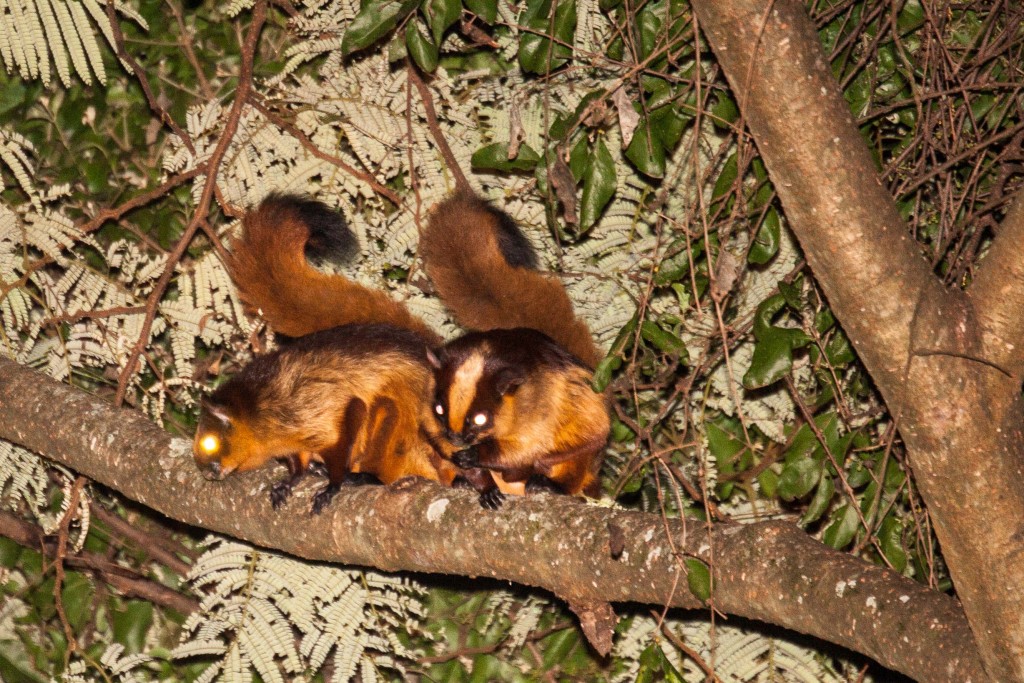
Bhutan Giant Flying Squirrels, Petaurista nobilis
A kilometre further on we picked up some more eyeshine on the cliff so decided to walk along the road. That eyeshine remains unidentified. But during the walk we heard several Himalayan Gorals’ distinctive sneezing call, and eventually saw a couple, but not well. I got a better look at one below the road, half hidden behind a log. At first I thought it was a Barking Deer, but the white ears and white throat patch were distinctive. However, Golden Cat aside, the highlights of the evening were the flying squirrels. We must have seen at least 10 Bhutan Flying Squirrels. Most of them were in pairs (I guess they were breeding) and for once I got some decent pictures. I could, however, have got much better pictures if the batteries in my flash hadn’t died.
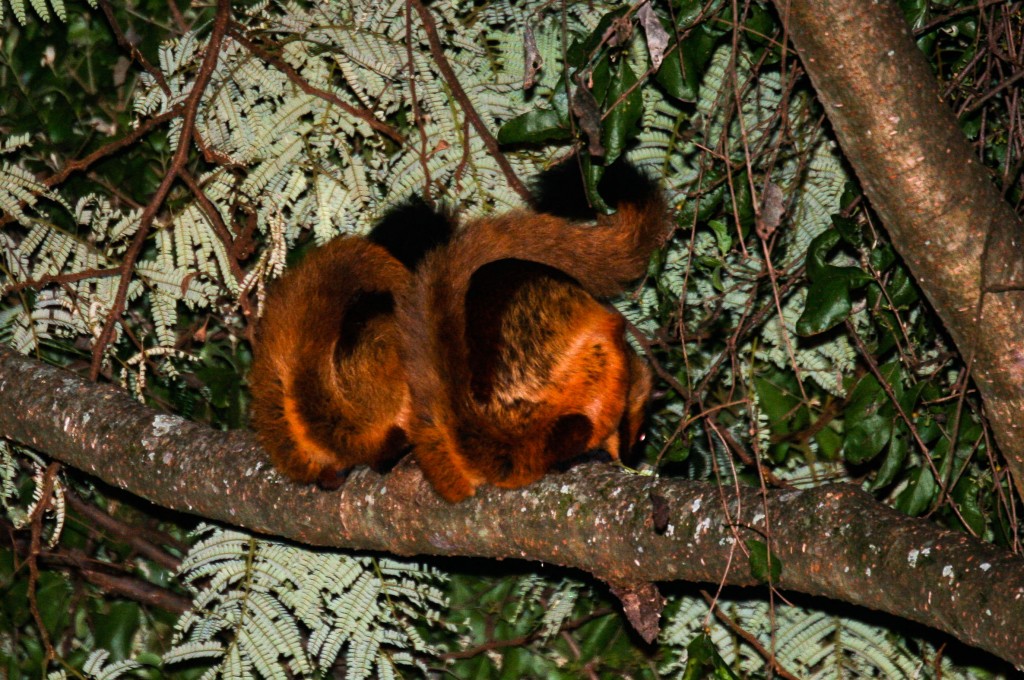
Bhutan Giant Flying Squirrels, Petaurista nobilis
Rinchen and I saw a couple of squirrels on the cliff face only 10 metres above us. Apparently they often come to the ground on roads to lick minerals so perhaps they were doing that here. We watched them for a minute or so while I faffed with my flash trying to get it to work.
Rinchen let out a yell, and I looked up to see two large flying squirrels sailing straight towards us. We both ducked and the squirrels landed on the edge of the road, just three metres behind us. One was stunned and I could have got some great close ups….if my batteries had been in better condition….. Now I don’t know whether their acrobatics were designed to escape us, or to frighten us, but they were successful on both counts. If we hadn’t have ducked I’m certain I would have been wearing one as a hat. After surviving close encounters with several dangerous animals over the years, being mauled by a flying squirrel would have been somewhat ignominious.
The squirrel that landed closest to us gathered its thoughts then climbed up a small tree near the roadside and sat in the spotlight for 10 minutes, calling, presumably, for its mate.
So a great evening: one of the best night’s spotlighting I’ve ever had.
Gelephu
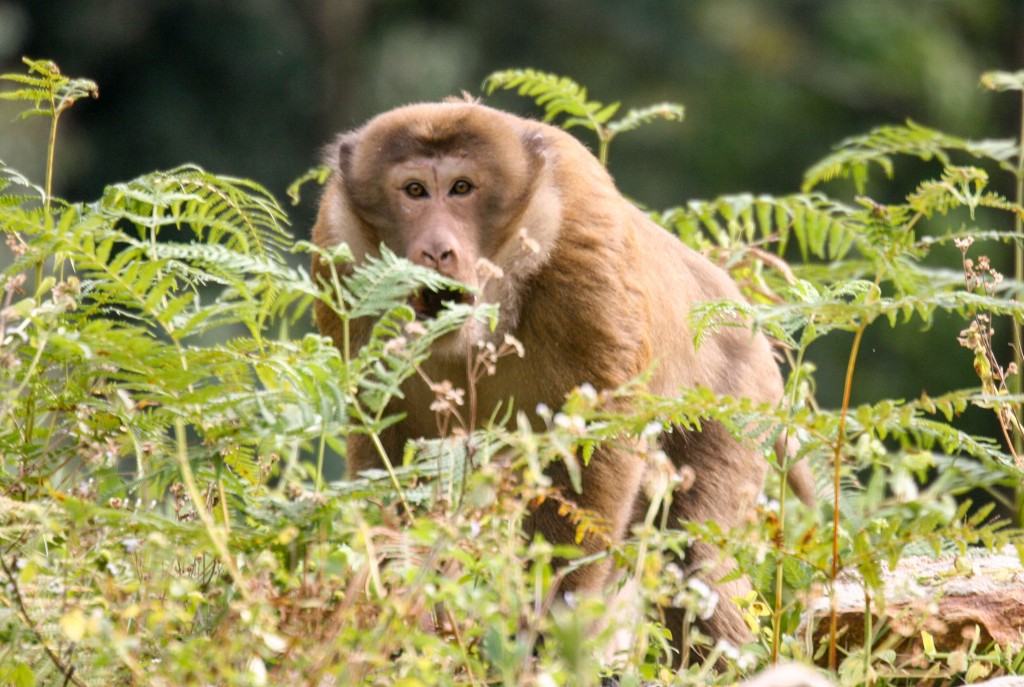
Assamese Macaque, Macaca assamensis
We spent my last day on the long drive to Gelephu. We saw a few groups of Assamese Macaques along the roadside, and a few more Golden Langurs. Soon after the village of Tingtinbi we saw a pair of Yellow-throated Martens cross the road.
We got to Gelephu quite late, and headed straight to a patch of forest just past the village of Buhr to try for the lowland Golden Langur subspecies. The sun was setting but less than a kilometre along the dirt track towards a sand quarry (a few kilometres out of Buhr and just over a bridge) we spotted some langurs. They were more brightly coloured than their highland cousins. I took a quick stroll down the road to look for Hoary-bellied Squirrels. Rinchen heard their calls within five minutes and we got close to a group of four.
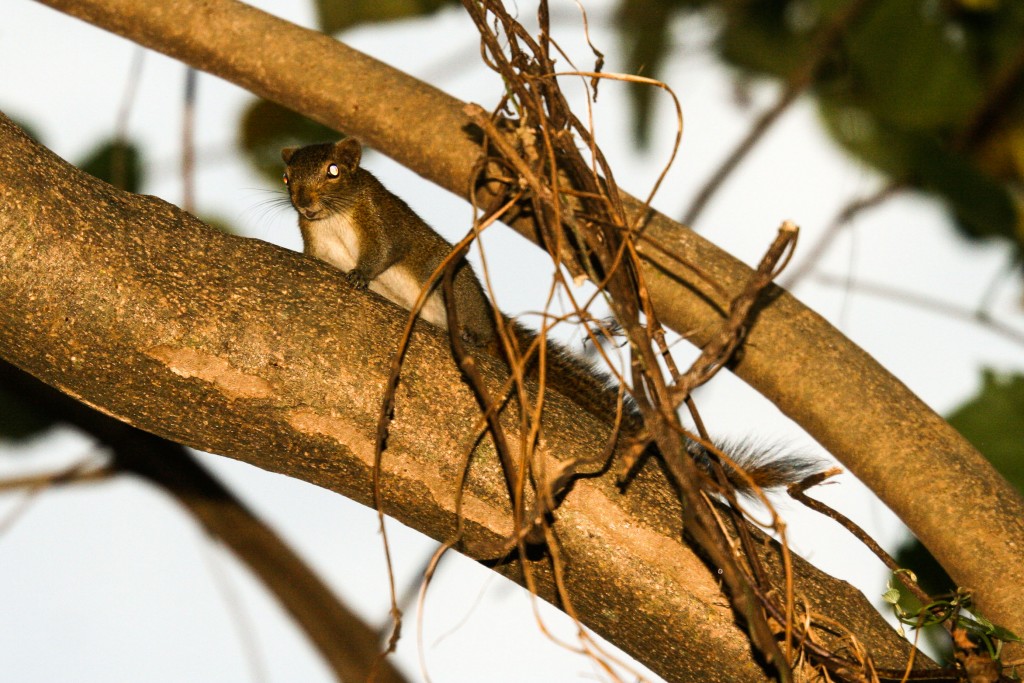
Hoary-bellied Squirrel, Callosciurus pygerythrus
Driving around Gelephu is restricted after dark because of security concerns along the border. So we sat in the hotel and drank warm Fosters. The next morning I crossed the border into Assam.
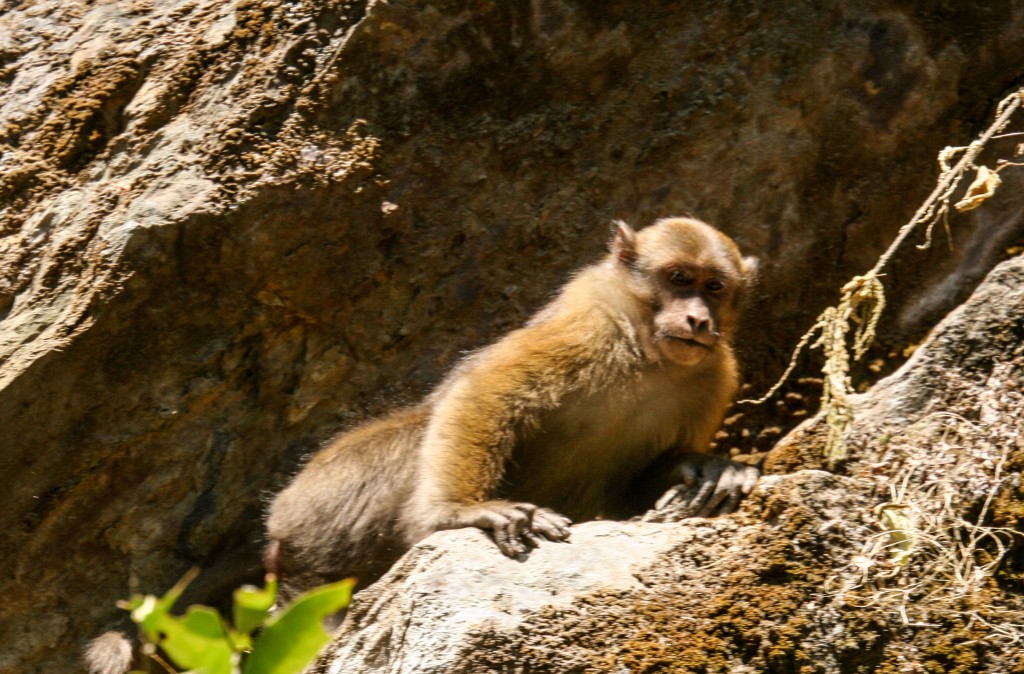
Assamese Macaque, Macaca assamensis
The trip was too short. But it was long enough to find 15 mammal species, 10 of them lifers. I also saw a lifetime’s worth of beautiful scenery, with villages straight from the pages of a fairy tale. So go if you can, and go before it changes.
Stuff I Missed
I would like to have gotten better views of several species that I saw only very briefly, like the Serow, Royle’s Pika, and Golden Cat. And it would have been nice to have seen Gorals better. But the one species that I looked for and dipped on was a Red Panda, even if in reality it was a longshot. I think further east they are a bit more findable and if I return I would focus on spending more time up above 3,000 metres looking for them as well as for Woolly Flying Squirrels.
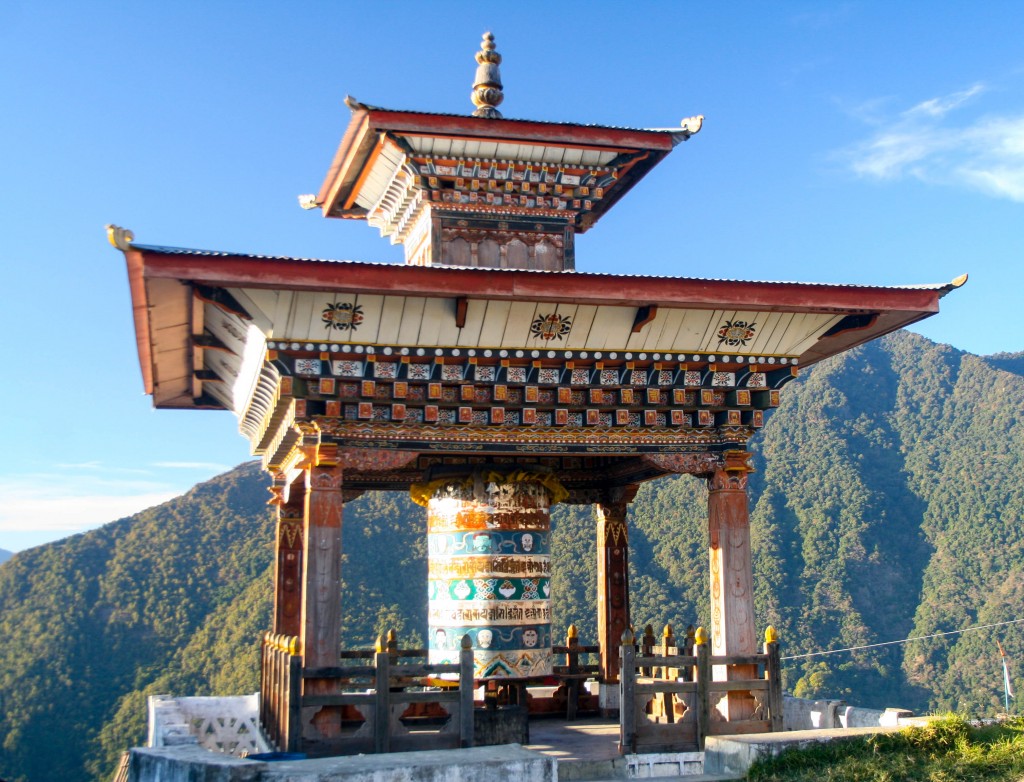
Trip List
Sijn Pika Ochotona sikimaria
Orange-bellied Himalayan Squirrel Dremomys lokriah
Hoary-bellied Squirrel Callosciurus pygerythrus
Particolored Flying Squirrel Hylopetes alboniger
Hodgson’s Giant Flying Squirrel Petaurista magnificus* (possibly)
Bhutan Giant Flying Squirrel Petaurista nobilis
Asiatic Golden Cat Felis temminckii
Leopard Cat Felis bengalensis
Yellow-throated Marten Martes flavigula
Assamese Macaque Macaca assamensis
Nepal Langur Semnopithecus schistaceus
Golden Leaf Monkey Trachypithecus geei
Barking Deer Muntiacus muntjak
Sambar Cervus unicolor
Himalayan Goral Naemorhedus goral
Serow Capricornis sumatrensis
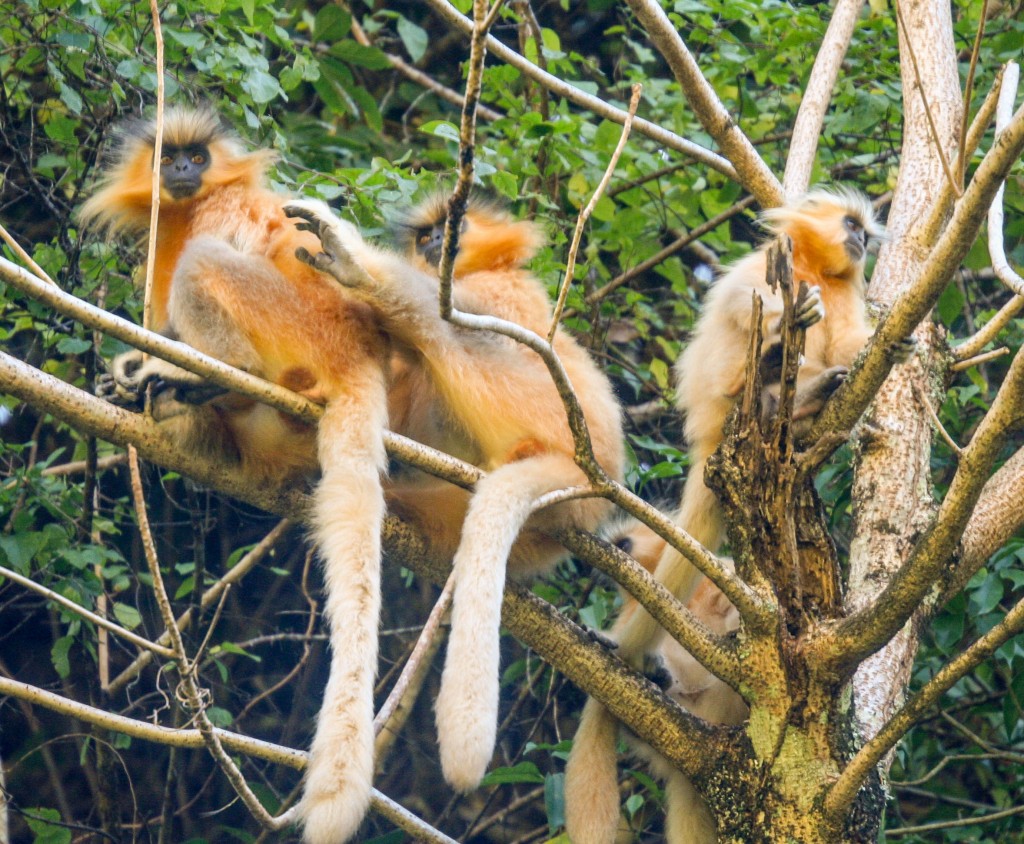
Bhutan Golden Langur, Trachypithecus geei bhutanensis
Community Reports
Cat sightings, 2015 – 2023: Flying Panda’s notes about seeing Marbled and Leopard Cats, plus Leopard over the years.
Jigme Singye Wangchuck NP, 2024: Flying Panda, 4 days & 5 species including Golden Langur.
North East India & Bhutan, 2016: Ralf Bürglin, 17 days & 20 species including Brown Himalayan Goral, Capped Langur and Hoolock Gibbon.
Bhutan, 2016: David Bishop, 3 weeks & 14 species including Capped and Golden Langurs, Smooth-coated Otters and Hodgson’s Giant Flying Squirrels.
India & Bhutan, 2014: Susan Andelt, 2 weeks with species including Tiger, Nilgai and Capped Langur.
Bhutan, 2013: Jeff Blincow, 17 days & 14 species including Himalayan Goral, Hodgson’s and Particolored Flying Squirrels and a Yellow-throated Marten.
Bhutan, 2010: Michal Polanski, 2 weeks & 11 species including Goral, Yellow-throated and Stone Martens.
Nepal & Bhutan, 2011: Royle Safaris, 22 days & 22 species including Jungle Cat and Sloth Bear.
Bhutan – some notes, 2007 : Dion Hobcroft, several trips.
Also See
Field ID of Hodgson’s (Petaurista magnificus) vs Bhutan Flying Squirrels (P. nobilis), June 2024
Jumotsjamgkha Wildlife Sanctuary, May 2024
Samtse, May 2024
Paro, May 2024
Himalayan Goral, April 2024
Puzzling Pikas at Pelela Pass, January 2024
ID required for a Bhutanese rat, December 2023
Resources
Wangchuk, T. 2004. A Field Guide to the Mammals of Bhutan. Department of Forestry, Ministry of Agriculture, Bhutan. The field guide covers all the Bhutanese species, though doesn’t have information or illustrations for all the bats or rodents. There is also information on which species occur in which parks. If the book is to be believed then no mammals in Bhutan are endangered …


Leave a Reply
You must be logged in to post a comment.